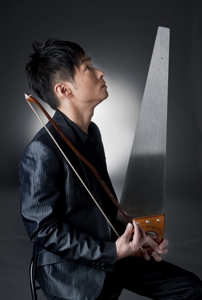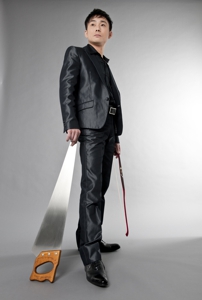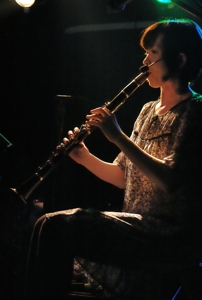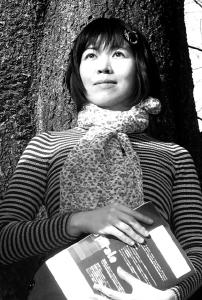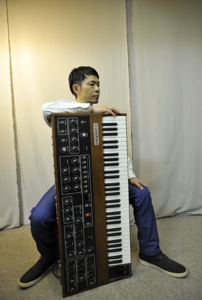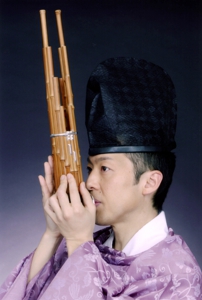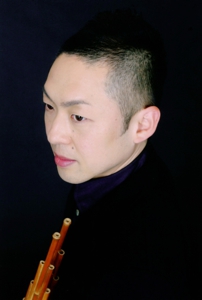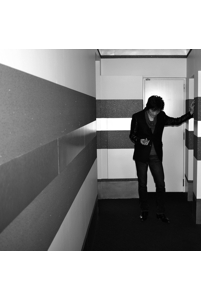1. Helium Leak
Hajime Sakita — Musical Saw
Hajime is so celebrated as a musical saw performer that he’s been ranked the world’s best twice. His saw produces sounds that awaken the entire spectrum of human emotions, sounds that blanket you like a comforting mist as you drift across the Sanzu into the pleasant afterlife. That a tool for cutting wood can build such provocative sounds is incredible.
Official website
2. At An Angle Of 120 Degrees
Kaori Tsutsui — Clarinet
The clarinet has a very special timbre that sets it apart from other instruments. The odd-numbered harmonics that make up the single-reed’s tone color are quite clearly contrived. And yet the clarinet’s tone is a masterpiece of human-engineered sound. Thanks to her effortless control of the instrument, Kaori’s performance is both graceful and acrobatic, reminiscent of a circus trapeze artist.
Profile:
Kaori Tsutsui, clarinetist and composer
Music history
Kaori took up the piano at age four, the recorder in elementary school, and the clarinet in Year Six of elementary school. After studying music at Takamatsu-Daiichi Upper Secondary School, she went on to complete a graduate course at Musashino Academia Musicae in 1998 and a special post-graduate course in composition at the same university in 2012. She is currently enrolled in a composition course at the Ecole Normale de Musique de Paris.
She has played the clarinet at many concerts and live music shows in Japan and other countries and has composed music for several notable commercial works.
To date, she has studied the clarinet under Takashi Ishikawa, Kalman Berkes, and Guy Deplus, the recorder under Tomokazu Ujigawa, chamber music under Janos Cegledy, composition under Seiichi Sato and Michel Merlet, and counterpoint under Stéphane Delplace.
Alphonte Music
3. Invisible Rays
Prophet-5
The Prophet-5, alongside the Minimoog, is the most famous analog synthesizer in the world, and it’s probably the most profitable synthesizer of all time too. Where the Minimoog is monophonic however, the Prophet-5 has five-voice polyphony, which means it can play chords. Polyphony made the instrument a standout when it was released in the late 70s, and its diverse sound textures and unvarnished, irrepressible tones still surpass today’s synthesizers.
Profile:
“The Prophet 5 contains five individual voices. For its principal sound sources each voice contains two VCO's (voltage controlled oscillators), OSC A and OSC B, and a white noise source which can be mixed into a resonant low-pass VCF (voltage controlled filter). The filter modifies the voice timbre under control of its four-stage envelope generator. The filter may also be resonated and serve as a sound source. Following each filter, a VCA (voltage controlled amplifier), also controlled by a four-stage envelope generator, shapes the voice amplitude. Supplementing the basic voices are polyphonic modulation (POLY-MOD) signal routings within each voice that allow OSC B and the filter envelope generator to function as modulation sources applied to OSC A frequency or pulse width, or the filter frequency. Finally, there is a single LFO (low-frequency oscillator) and a pink noise source which can be mixed to modulate all five voices, as adjusted by the MOD wheel.
“The Prophet-5 sustained six revisions (or revs). Rev 1 was the original design. Rev 2 was a refinement of the original design and largely transparent. Rev 3, however, was a vastly different synthesizer than Revs 1 and 2. Introduced to Rev 3 were new voltage controlled IC's (CEM), an improved ADC, DAC, and a different control voltage distribution scheme. More sophisticated editing and tuning routines were designed, and to improve serviceability, voice trimmers were reduced from 80 to 45. Some believe that the Rev 3 synthesizers are slightly inferior (sonically) to their predecessors by revealing an absence in the lower frequencies. While this may be true, the majority of the Rev 3 synthesizers are far more operationally stable than their Rev 1 and Rev 2 counterparts.”
Excerpt from synthmuseum.com
http://www.davesmithinstruments.com/
4. Silver
Ko Ishikawa — Sho
The sho bamboo pipe brings to mind a beam of light shining in the darkness, aspirations, and a silver sky. Each breath blown through the instrument, each modulation in the sound, is like a signpost.
This ancient instrument from Japanese gagaku court orchestras consists of 17 slender bamboo pipes. Each of the pipes reconstitutes the radiance of a unique word. When several of the pipes are played together, the resulting chord is staggering in its luminosity.
Profile:
Ko Ishikawa, sho performer
Since his beginning as a sho performer in 1990, Ko has performed at music festivals around the world. Not limited to classic gagaku pieces, he performs contemporary and original works as well as improvisational pieces.
http://radiant-osc.com/
5. Visible Rays
Masatoshi Katsumata — Sound FX
Some sounds are more realistic than reality. This is the work of a man who has been projecting exacting, three-dimensional sounds onto the film world, a man who can make you see a man riding a bicycle in a daydream.
Profile:
Masatoshi Katsumata: Supervising Sound Editor
Masatoshi has participated in numerous live concerts and recording sessions spanning a myriad of musical genres and generations as well as being involved in music production work as a mixer.
He began working in film projects as a sound mixer in the early 1990s. This led him to become heavily involved in post-production sound work for films. Currently, he spends his time as a sound editor and as a sound mixer for Foley artists mainly for movies but also for TV programs, live concerts, and videogames.
Recent projects include Rurouni Kenshin, Dokuro Shiro no Shichinin by Geki Cine, Neo Ultra Q, Glay’s Justice & Guilty arena tour, and Koji Kikkawa’s “Samurai Rock” music video.
6. Wolf Whistle
Satoshi Izumi — Electric Guitar and Acoustic Guitar
Although his guitar sound is unrepentant rock — a sound that longs to romp around like a delinquent bunny, Satoshi’s lifestyle is the farthest thing from your unbalanced, decadent rocker.
Profile:
Born in 1978, Satoshi was lucky enough to get a chance to play with the legendary Takeshi Terauchi at age 15 and his performing career began soon after. In his 20s, he played in many groups, including Shigeo Fuchino, Maki Asakawa, Kankawa122, and fayray. He has been playing in Yuji Ohno & Lupintic Five, a band led by pianist and composer Yuji Ohno, since 2006. At the same time, he has developed a reputation as a session, recording, and touring musician and is a well-respected sideman for a number of overseas musicians, such as bassist Chuck Rainey.
He also performs as a solo artist, playing classical and electric guitars as well as handling vocal duties. Satoshi continues to draw attention for his original sense and interpretations even as he respects his relationships with famous musicians in all kinds of scenes, from jazz, rock, and soul to classical.
http://xxxxx.main.jp/izumisatoshi/
